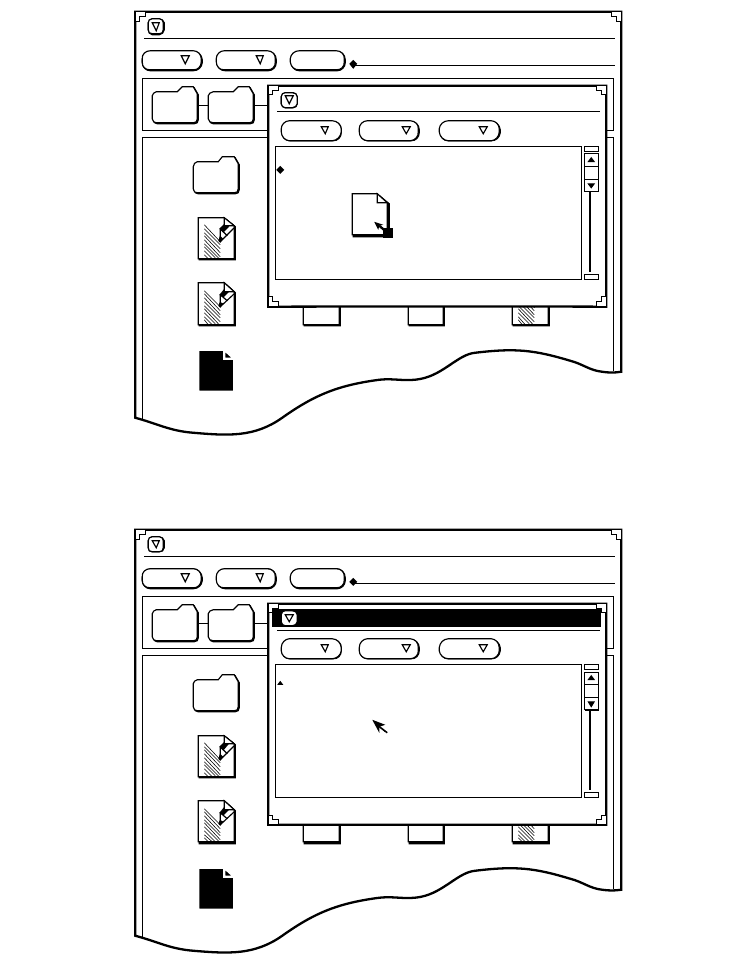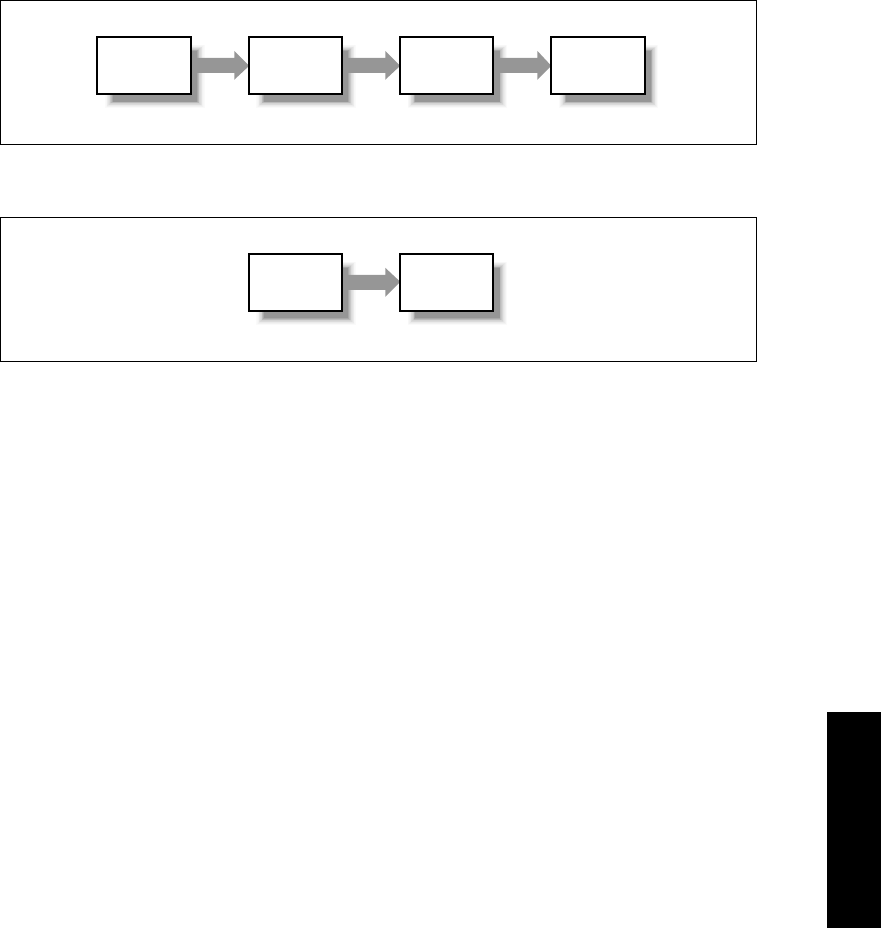
19
Drag and Drop
This chapter describes the XView packages that support drag and drop. Drag and drop
allows data to be moved within an application or between applications. Using drag and drop,
objects are selected, then moved or copied to a new location. The selected object is the drag
and drop source. Selecting the source is referred to as sourcing the drag. An area within the
source application or within another application receives the drop in a pre-registered drop-
site.
This chapter describes packages that are new for XView Version 3. The function
xv_decode_drop() that supports dragging and dropping is now obsolete. Note that
xv_decode_drop() will not work correctly once an application is compiled for V3. The
function is still provided for backwards compatibility for XView Version 2 programs.
Many OPEN LOOK applications use drag and drop operations. For example, an application
may allow text in a text subwindow to be sourced and copied or moved to a new location
within the text subwindow. Similarly, a File Manager’s file icon can be selected and dragged
to the Print Tool icon for printing. OPEN LOOK defines many uses for drag and drop, includ-
ing loading files into an application. Figure 19-1 shows a file being dragged into an editor
and Figure 19-2 shows the application loading the file (receiving the drop).
Drag and drop supports drop previewing where the drop-site image changes to show that it is
a valid drop-site. It also supports drag feedback where the pointer image changes to indicate
that an item is being dragged. The data transfer for an XView drag and drop operation is nor-
mally implemented using selections. You need to be familiar with the selection package to
use drag and drop. The selection package is described in Chapter 18, Selections. Note that
the operation of drag and drop using OPEN LOOK differs from selections in the following
ways:
• Drag and drop is a single gesture rather than a series of separate actions.
• Drag and drop operates on complete pre-registered data objects. Using drag and drop, the
application decides which areas may be selected, and then the user may select and drag
the area.
Drag and Drop
Drag and Drop 433

File Manager
File Edit Goto:
/ home
Chapters
Balloons.rs
Cat.rs
romance.doc
chapter1.doc chapter2.doc jester.rs
Edit
File View Edit
Figure 19-1. Dragging a file onto an application
File Manager
File Edit Goto:
/ home
Chapters
Balloons.rs
Cat.rs
romance.doc
chapter1.doc chapter2.doc jester.rs
Edit
It was a dark and stormy night. All
of the beagles were safely in their
kennels. The bats flew around the
tower squeaking frantically.
Dosalina stood at the open window
wistfully gazing out over the moors.
File View Edit
Figure 19-2. Loading a file by dropping
434 XView Programming Manual

19.1 Drag and Drop Objects
Drag and drop is facilitated using two objects: DRAGDROP and DROP_SITE_ITEM; a
DRAGDROP object represents the source of the drag. A DROP_SITE_ITEM object indicates a
destination that is a valid drop-site. All applications need to include the file
<xview/dragdrop.h> to use these packages. All DRAGDROP attributes are prefixed by DND and
all DROP_SITE_ITEM attributes are prefixed by DROP_SITE. Both Figure 19-3 and Figure
19-4 show the class hierarchy for these objects.
Generic
Object
(Selection)
Selection
Owner
DRAGDROP
Figure 19-3. DRAGDROP class hierarchy
Generic
Object
Drop Site
Figure 19-4. DROP_SITE_ITEM class hierarchy
Drag and drop operations involve three steps which the following sections describe:
• The application that is to receive the drop must register a region or several regions as
valid drop-sites. This lets the application inform other applications that it is interested in
receiving drops.
• The application containing the source for the drag and drop determines the point at which
to initiate the drag operation. For example, a drag operation could be initiated when text
or a file icon is selected and dragged. A
DRAGDROP object is created by the source appli-
cation. The drag begins when the application calls the procedure dnd_send_drop().
• An application that has registered a drop-site must be prepared to receive a drop.
Drag and Drop
Drag and Drop 435
19.2 Registering Drop-sites
An application that is to receive a drop must register a region or several regions as valid
drop-sites. This allows drag sources to determine the validity of potential drop-sites and
enables the application to receive the events for previewing and dropping. For example, a
graphic icon or any other window may be registered as a drop-site. The drop-sites may con-
sist of one region or of several regions described by one or more rectangles within the appli-
cation. If an application does not register an area as a drop-site, it cannot receive or preview
drops.
An object instantiated from the DROP_SITE_ITEM package describes a drop-site. A drop-site
item is subclassed from the GENERIC package and is not a visible object. The following
example demonstrates how to make the rectangle representing an entire window a drop-site:
drop_site = (Xv_drop_site)xv_create(window, DROP_SITE_ITEM,
DROP_SITE_ID, 1234,
DROP_SITE_REGION, xv_get(window, WIN_RECT),
DROP_SITE_EVENT_MASK, DND_ENTERLEAVE | DND_MOTION,
DROP_SITE_DEFAULT, TRUE,
NULL);
Instances of DROP_SITE_ITEM are owned by window-based objects. The attribute
DROP_SITE_ID is an uninterpreted ID that may be used by the application to distinguish one
drop-site from the next. This attribute is useful when more than one drop-site is set on an
object (see Section 19.2.2, “Handling Events,” for details on using this attribute). Section
19.2.1, “Adding and Deleting Regions,” describes regions and the attribute
DROP_SITE_REGION. The attribute DROP_SITE_EVENT_MASK is a mask set on the drop-site
item. It is used to specify if the region(s) within the drop-site should receive preview events
(see Section 19.2.2, “Handling Events,” for more details).
DROP_SITE_DEFAULT establishes a default drop-site for drops forwarded from the window
manager. Such drops include drops on icons and window manager decorations. Only one
drop-site default should be specified per base frame; specifying more than one will have
unpredictable results. Setting this attribute provides only a hint to the window manager. The
drop-site default is used most often as a way to have drops forwarded from iconified applica-
tions.
19.2.1 Adding and Deleting Regions
Individual drop-site regions should correspond to those objects within the window that may
receive drops. For example, if there is a 64x64 icon at (10,10) within a canvas that is an
acceptable drop-site, then a drop-site item should be created. The drop-site item’s region
should be set to a rectangle with coordinates at (10,10) and a size of 64x64. If the position of
the objects within the window change or the objects are clipped by other objects, it is the
responsibility of the application to update the drop-site item to correspond to the new posi-
tion of these items. For example, if an object is deleted, its region should be removed. If an
object is being clipped by its containing window border, or a sibling window border, and is
no longer viewable, its region should be removed or updated to reflect the viewable portion
of the drop-site. If an object moves, relative to the base frame, the drop-site item region
436 XView Programming Manual

needs to be updated by deleting the old region and adding the new, updated region. Drop-
sites obscured by other application windows need not be updated. When the window that
owns a drop-site is unmapped, the drop-sites it owns are also unmapped (made “invisible”) to
drop sources. They are returned when the window is mapped again.
If an application does not keep the region information up-to-date, users may be given false
indication that old drop-site areas can receive drops.
If a drop-site item’s owner is destroyed with xv_destroy(), any drop-site regions atta-
ched to it are also destroyed.
The attribute DROP_SITE_REGION associates a region to a drop-site item.
DROP_SITE_REGION appends regions to any existing regions within the drop-site item. The
coordinates in the rect should be relative to the drop-site item’s owner’s window. An
xv_get() of a region returns a pointer to an allocated Rect * structure. This should be
freed using xv_free() once the application has finished using it.
The attribute DROP_SITE_REGION_PTR is similar to DROP_SITE_REGION except that it
accepts a NULL-terminated array of regions. It appends to any existing regions within the
drop-site item. A NULL rect is defined to be one with width or height equal to 0.
The DROP_SITE_DELETE_REGION attribute removes a region from the drop-site item. When
a NULL is passed as a value for this attribute, all regions in the drop-site are removed.
The DROP_SITE_DELETE_REGION_PTR attribute removes a list of regions from the drop-site
item. Passing a NULL as an argument removes all regions in the drop-site. Typically, when a
region needs to be updated, xv_set() should be called with two attributes:
DROP_SITE_DELETE_REGION_PTR with a NULL value, followed by DROP_SITE
_REGION_PTR
. Note that the order of these two attributes is important.
19.2.2 Handling Events
The drop-site item’s owner is a window. The event procedure for the owner window receives
the drag and drop action events and handles them accordingly. Drag and drop semantic
events are shown in Table 19-1.
Table 19-1. Drag and Drop Semantic Events
Event Purpose
ACTION_DRAG_PREVIEW Preview event.
ACTION_DRAG_MOVE Move the source data to the drop-site window.
ACTION_DRAG_COPY Copy the source data to the drop-site window.
Drag and Drop
Drag and Drop 437
Get Volume 7A: XView Programming Manual now with the O’Reilly learning platform.
O’Reilly members experience books, live events, courses curated by job role, and more from O’Reilly and nearly 200 top publishers.

